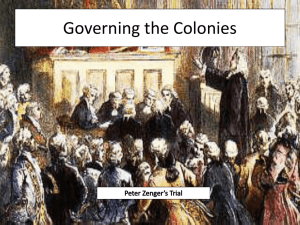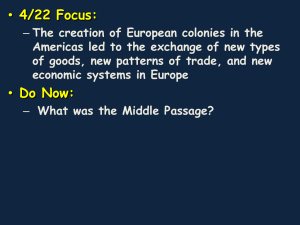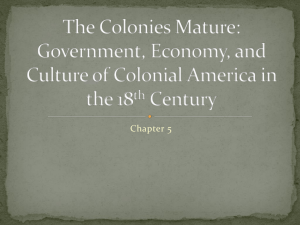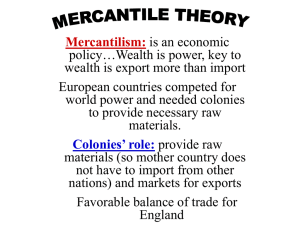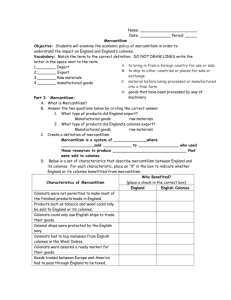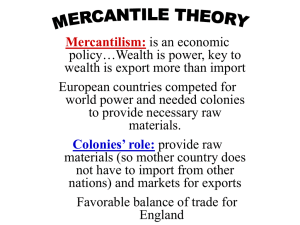Mercantilism and Triangular Trade
advertisement
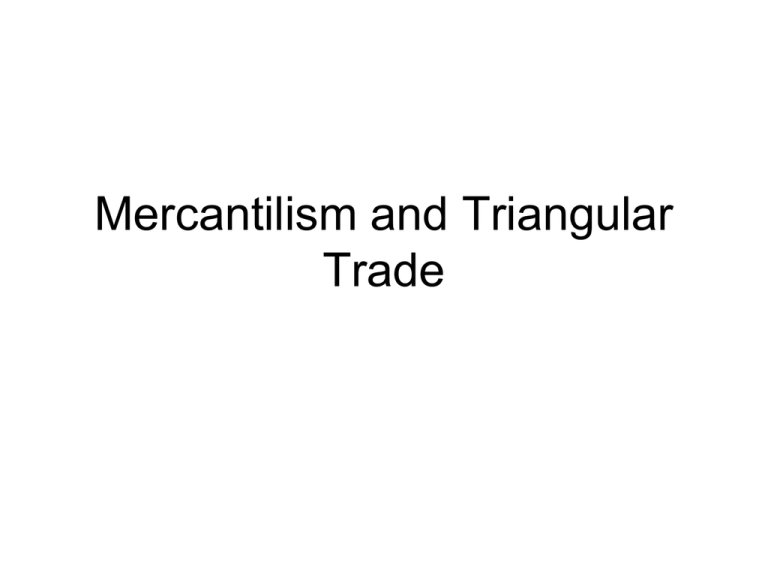
Mercantilism and Triangular Trade Overview Mercantilism is an economic system practiced by European countries from around 1600 through the 1700’s. It established patterns of trade that helped shape the 13 colonies. Goals First: Create a favorable balance of trade. Each country wanted to EXPORT more products than it IMPORTED. Second: You want to maximize the amount of gold and silver in your country Weakness Each country in Europe practiced mercantilism. Thus, nobody really wanted to trade with each other, as that was seen as strengthening your enemy. Some trade could not be avoided, but it was not enough to grow the economy and keep people employed. Solution Colonies provided the answer. Colonies provided a market for England’s industrial goods such as metal tools and cloth. Solution To feed English industry, the colonies provided raw materials, such as lumber, iron, and food. Making it Work For Mercantilism to work, you can’t let your colonies trade or export goods to other countries. England passed laws to control colonial trade. Navigation Acts The Navigation Acts of 1660 were the earliest attempts by England to control colonial trade. They said all goods had to be shipped on boats built in England, and that the colonies could not trade with foreign countries. Effect on Colonies Under mercantilism, the 13 colonies developed little industry or the ability to manufacture finished goods such as tools and firearms. The economy was focused on agriculture and the production of raw materials (lumber and iron ore). Effects on Colonies Smuggling became common as colonists resisted these trade rules that decreased their imports. The colonists learned early to defy the authority of the English government. Triangular Trade Triangular trade grew out of a combination of the slave trade and the Mercantilism economic policy of England. Triangular Trade The demand in England for raw materials and agricultural products such as rice, indigo, tobacco, and cotton helped fuel the transatlantic slave trade between Africa and the Americas. How it got its name In triangular trade, each trade route had three stops. Thus, a triangle is formed when plotted on a map. Trade Route #1 1. From Africa, slaves are sent to the West Indies. 2. From the West Indies, molasses and sugar are sent to the 13 colonies. 3. From the 13 colonies, raw iron and rum are shipped to Africa. 4. These are traded for more slaves, and the process starts over again. Trade Route #2 1. From England, pots, pans, firearms, and rum are shipped to Africa. 2. From Africa, slaves are shipped to the colonies in America. 3. From the colonies, lumber, iron, grain, and rum are shipped to England. Impacts of Mercantilism: England 1. England’s economy thrives due to its ability to sell manufactured products to the colonies. 2. The large amount of wealth generated will help fund wars against France and Spain for control of the Americas. Impacts of Mercantilism: Colonies 1. Very little industry is developed due to restrictions placed by England. 2. Smuggling becomes common as colonists try to get around trade restrictions. The colonists learn to defy the authority of the English government. 3. Economy is based on supplying raw materials to feed English industry. Impacts of Mercantilism: Africa 1. A huge migration of human beings take place, as Africans flee the slave traders and move inland. 2. Traditional cultures are disrupted due to the introduction of firearms and manufactured goods. 3. Many areas on the coast see a dramatic decrease in population due to the slave trade.

